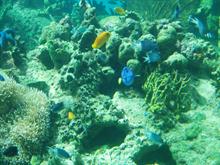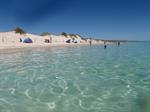WHAT IS NATURE TOURISM?
Natural Attractions
 Natural attractions are geographical or biological features that have a specific appeal to the tourism market. Globally, there are countless varieties of natural attractions – no two natural attractions are the same because they have been shaped by the unique natural forces of the surrounding environment. Natural attractions include deserts, polar regions, rainforests, alpine areas, woodlands, grasslands, mountains, beaches, swamps, caves, oceans, cliffs, and rivers, as well as the unique life forms that inhabit those environments (animals, birds, insects, and plants).
Natural attractions are geographical or biological features that have a specific appeal to the tourism market. Globally, there are countless varieties of natural attractions – no two natural attractions are the same because they have been shaped by the unique natural forces of the surrounding environment. Natural attractions include deserts, polar regions, rainforests, alpine areas, woodlands, grasslands, mountains, beaches, swamps, caves, oceans, cliffs, and rivers, as well as the unique life forms that inhabit those environments (animals, birds, insects, and plants).
We visit natural attractions for many reasons, including:
- To enjoy the grandeur of nature.
- To escape from the pressures of urban life.
- To escape from humanity.
- To explore different landscapes.
- To experience outdoor adventures in a natural setting.
- To learn about the environment.
- To participate in conserving the environment.
Some natural attractions are close to cities and transport systems whereas others require considerable effort to get there – which can be part of their appeal.
Some natural attractions are highly publicised and attract hundreds of thousands of tourists across the globe each year. Others are hidden treasures known only to a lucky few. Some natural attractions have multiple tourist facilities such as accommodation, guided tours, cafes, shops and the like but others have little or no development.
However, regardless of any attraction’s location, popularity, or associated development, it needs to be managed so that humans do not degrade the natural ecosystems, such as -
- animals
- plants
- geology
- river systems etc.
These are an intrinsic element of the attraction, but they have also taken millions of years to evolve and should be treated with respect.
Definitions

Different terms are used to describe tourism in natural environments. These include:
- Nature-based tourism: a broad term that covers all tourism experiences centred on wild or natural environments.
- Environmental tourism: tourism that takes place in natural settings with an emphasis on understanding and conserving natural environments.
- Ecotourism: tourism that has minimal impact on fragile natural environments and which focuses on providing nature-based experiences.
- Wildlife tourism: tourism that provides close contact with wildlife and nature in general.
- Adventure tourism: tourism that usually (but certainly not always) takes place in wilderness environments. Often, the natural environment is a venue or backdrop for adventure activities and the focus is on the activities rather than the environment.
Sustainability and Ecotourism
Tourists are attracted to natural sites by their images of what that environment might have to offer. While a site might not be quite what was imagined, it should never disappoint and it should always provide an experience that is both aesthetically and intellectually pleasing. This means that aside from the natural beauty of the place, the site should be managed to meet at least minimum expectations of a clean, healthy, flourishing environment. Otherwise, tourism at that site or in that region will fail. Therefore, protection and preservation of the environment in its natural state, or as close to it as possible, is essential, as is the development of sensitively designed facilities, including pathways, picnic areas, accommodation, and service areas. Tourism success at natural sites, and increasingly at urban sites, depends on the quality of the environment. Good tourism development involves protecting that environment whilst allowing for safe and sensitive access to its attractions. Sometimes, it is a simple matter of clearing a trail through a rain forest and careful planning and consultation to anticipate and prevent potential harm.
Some environments are inherently more fragile than others. The environment of a tropical island, for instance, is easily damaged and the impact of moderate tourism on a small island can be much worse than on the mainland.
Another problem is that natural sites may be far away from accommodation or large travel facilities such as mainland airports or bus depots or from island airports and hotels. However, some airports which drop visitors off to remote areas such as the New Guinea highlands are necessarily close to the natural attractions. Alternatives may be costly and difficult to achieve. Nevertheless, they may ultimately be worth the effort since facilities that are developed to serve tourists will also serve the local people and enable them to travel out of their remote areas and bring services and goods in more easily. Where the costs of such developments for the sake of the local people alone are prohibitive - tourism can provide the impetus and justification for development that benefits the locals as well as tourism.
Sustainable tourism aims to achieve a balance between preserving natural environments with the needs of tourists. The best-known form of sustainable tourism is ecotourism, which has a strong focus on visitor participation and education. The main characteristics of ecotourism are:
- It does not degrade the resource or attraction.
- It promotes positive environmental ethics.
- Its emphasis is on natural ecosystems rather than humans.
- It provides visitors with a first-hand experience of the environment.
- It educates visitors about the environment.
- It benefits the wildlife and the environment.
Ecotourism is an important niche in the special interest tourism industry. Worldwide, it is one of the fastest-growing sectors in the tourism industry. It is particularly important to the economies of developing countries that have many natural attractions but limited resources to develop facilities for mainstream tourism.

Ecotourism attracts people who wish to visit relatively undisturbed environments in order to enjoy and appreciate nature. Most ecotourism attractions have a strong emphasis on providing their guests with an understanding of the environment by providing first-hand experiences, such as guided walks and wildlife safaris. Ecotourists are often encouraged to participate in conservation programs to help further their understanding and to benefit the environment, for example, assisting scientists to collect field data and samples.
In the long term, ecotourism can only work by limiting visitor numbers otherwise the attractions will degrade to the extent that visitors will no longer be attracted to them. In some areas, visitor fees are imposed to help restrict visitor numbers and also to cover maintenance costs. Supporting facilities such as accommodation may also be regulated. Those facilities that are necessary are designed to have minimal impact on the environment (e.g. composting toilets, recycled water, passive solar buildings). Areas subject to heavy tourist pressure might need laws to protect wildlife and sites, and to strictly control the selling and collection of natural items such as corals, shells, feathers, skins, claws, and suchlike.
Tourism development planning and management must consider the scale of tourism that is appropriate for a local environment and community. That includes considering:
- How many visitors the area can handle.
- What social or cultural impacts the community is willing to absorb.
- The capacity of resources to cope or recover.
Wildlife Tourism
 Wildlife tourism is based on tourists seeking to experience an area's fauna and/or flora. Curiously, there seems to be an inverse relationship between the rarity of the flora or fauna and its perceived value as a tourist attraction. Although many rare species do come to the attention of visitors through wildlife protection schemes, others which start to provide an income for the area gain protection inadvertently. Not only do rare species attract visitors, crowds are also drawn from around the world to view wildlife events such as migrating animals and dawn choruses.
Wildlife tourism is based on tourists seeking to experience an area's fauna and/or flora. Curiously, there seems to be an inverse relationship between the rarity of the flora or fauna and its perceived value as a tourist attraction. Although many rare species do come to the attention of visitors through wildlife protection schemes, others which start to provide an income for the area gain protection inadvertently. Not only do rare species attract visitors, crowds are also drawn from around the world to view wildlife events such as migrating animals and dawn choruses.
There exists a wide variety of activities and interests within the category of wildlife tourism. Some tourists will seek to be educated whereas others are attracted purely for the aesthetic experience. Activities may range from day trips to multi-week adventures. Popular activities include whale watching, safaris, bird watching, polar cruises, dolphin viewing, shark cage diving, coral reef snorkelling and more. Sites need to be selected based on sustainability, biological suitability, adequate visitor facilities, and appropriate protection for resources.
INTERESTED IN A CAREER IN TOURISM?
Do you have a passion for nature, for wildlife, or the environment? Then develop your knowledge and share it with others as a basis for your career, or business.
Environmental issues are hugely topical, and people's interest and awareness of the environment has increased substantially. This means a huge growth in demand for not only tourist business, but tourism with an ecological emphasis.
We offer a wide range of ecotourism and tourism courses.
You might also be interested in our Ecotherapy course.
If you are thinking of developing your knowledge in this area, why not enrol on a course today? If you need help in choosing a course or want to know more about studying with ACS, get in touch with our specialist Ecotourism and Adventure tutors today. They have a wealth of knowledge and experience and are here to help you.
